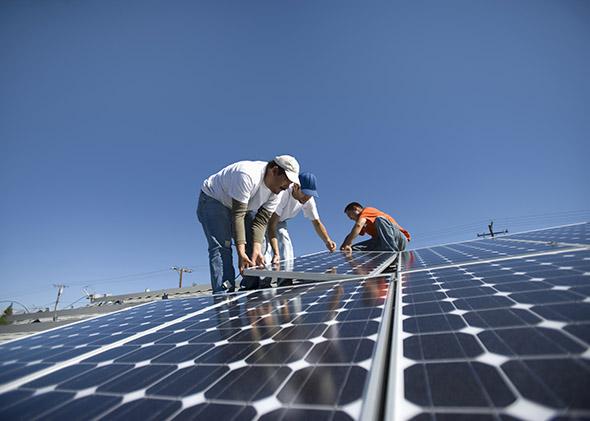One of the big raps on energy efficiency is that it’s hard for people and companies to imagine it as a capital-I investment. Sure, you get a quantifiable return on installing expensive new light bulbs today in the form of lower energy costs over time. But because purchasers of LEDS don’t get dividends or interest payments, it’s often difficult to regard them as anything other than a cost-saver.
That’s changing, thanks to imaginative investors, new state programs, and the alchemy of securitization, which has turned trillions of dollars in home mortgages into bonds. In fact, loans made to help building owners in Connecticut install solar panels or buy new boilers and lighting systems have been transformed into financial products that pay interest rates of up to 6 percent a year.
Under the state’s C-PACE program (for Commercial Property Assessed Clean Energy), the Connecticut state-run Green Bank takes funds it receives from a surcharge on state utility bills and other sources and makes cash available to building owners to make improvements. Like other banks, the Green Bank makes sure the borrower is creditworthy and ensures that the funds will be used for effective purposes. Borrowers take the money for 10 or 20 years, at rates ranging from 5 to 6 percent. “That enables the property owner to go beyond light bulbs, to go for deeper measures that take a bit more time to pay back,” said Bert Hunter, chief investment officer of the Connecticut Green Bank. It made its first loan in March 2013, it has approved about 90 loans worth about $70 million.
So far, so basic. But there’s a wrinkle. Because the improvements that it funds reduce fixed overhead costs instantly, C-PACE is in effect providing building owners with the financial means to pay back their loans. Connecticut’s program makes loans only to efforts that have a demonstrable and measurable ability to reduce ongoing operating costs, and by an amount more than the annual payment. As a result of the work, the costs to operate a building should fall by an amount greater than the monthly payment. (Each proposal goes through a process of evaluation, measurement, and verification that goes on for five years after the completion of the project.)
Another wrinkle. The loan is paid back through an assessment that is like a property tax. Owners make the payments when they make property tax payments. The payments attach to the building (if it is sold, the new owner is responsible for the payments), and they are collected by the municipality. And they have to be paid before a mortgage or other debt on the property. (This is similar to what the Louisiana company PosiGen, which I profiled last week, does for homeowners who want to go solar—they put no money down and start saving right away in exchange for signing on to a long-term financial obligation.)
C-PACE operates with a high level of transparency. Projects can be seen on this interactive map. A Baptist church in Bridgeport, Connecticut, received $51,000 to replace the boiler in its 145-year-old building, and has 10 years to pay it off. Each year, the church must pay $6,056 through the assessment; its annual savings in lower energy costs are expected to be $13,678. Insports, an indoor sports facility, took on $1 million in financing to construct solar panels and upgrade its lighting. It has 20 years to pay back the financing. The annual assessment is $83,171 per year, but the cost savings are estimated at $92,000 per year. (The Bridgeport News has a good feature on some of the participants in the program.)
The loans are now producing a stream of quarterly and annual payments, which are collected by local municipalities and funneled to the Green Bank. And as any introductory finance student knows, one person’s stream of payments can be someone else’s stream of income. Bankers and government agencies like Fannie Mae and Freddie Mac have been doing this for decades with home mortgages. A bank makes a bunch of loans. Instead of waiting 20 or 30 years to collect the payments, it sells them—or the rights to the stream of income they generate—to somebody else, who then issues bonds to investors backed by the monthly payments. The investors sit back and collect the interest and principal payments, and the lender takes the new money and puts it work.
Last year, Connecticut did a deal with Clean Fund, a finance company in San Francisco that specializes in CPACE transactions around the country. (So far, 25 states and the District of Columbia have passed legislation permitting C-PACE transactions.) Clean Fund wrapped up $30 million of the loans into a bundle and securitized them into bonds. Clean Fund bought $24 million of the bonds, while the Green Bank held on to $6 million. While the bonds are divided into different classes, one of the main groups pays an interest rate of 5.95 percent over 20 years. “If you compare it to a Treasury bond, it’s really attractive,” said John Kinney, founder and chairman of Clean Fund. (On April 2, a 20-year U.S. government bond was yielding just 2.29 percent.)
Of course, in contrast to government bonds, these new instruments don’t have much of a track record and can’t be traded. That’s why they pay a significantly higher interest rate. But this small bond nonetheless represents an important breakthrough. Profit-minded investors now have a method of providing relatively cheap capital to financially motivated building owners who want to make big outlays that will result in lower energy use and lower emissions.
Financial engineering has rarely been so green.
